Recent News
5 Ft Long Dead Moray Eel Washes Up On BeachTuesday, August 20, 2013
[Updated] What appears to be a dead eel was found washed up on an east end beach this afternoon [Aug 20].
Bermuda Zoological Society's "Reef Watch"
Monday, August 19, 2013
The Bermuda Zoological Society is hosting a “Reef Watch” on Saturday, August 31, which is designed to raise funds for reef conservation. Boats will depart at 12 noon, and the field report and dinner will take place at Barr’s Park from 4pm to 7pm.
Volunteers wanted for Island's first Reef Watch
Monday, August 19, 2013
The Bermuda Zoological Society (BZS) is calling all citizen scientists to help them carry out a health check on one of Bermuda’s most valuable resources — its coral reef system.
BAMZ curator hopes dolphin is outside the reefline
Friday, August 16, 2013
Authorities are still on the lookout for the lone dolphin that was feared stranded in Somerset Long Bay.
UK Zoo continues work with Bermuda skinks
Thursday, August 15, 2013
After finding themselves a new home in the Chester Zoo in the United Kingdom earlier this summer, the troubled Bermuda skink is getting a new chance at success as a species as zoo officials begin putting together a guide aimed at helping those with a hand in conservation services on the island to more easily breed and protect the highly endangered lizard.
About
GovernanceAbout Us
Newsletter
Latest News
Gift & Bookstore
Contact
General Inquiries
info@bzs.bm
Latest News
All the latest updates and news from the Bermuda Aquarium, Museum, and Zoo, one of Bermuda's leading visitor attractions!
Andy — a tiger shark tagged in Bermuda by scientists from Nova Southeastern University’s [NSU] Guy Harvey Research Institute [GHRI] in 2014 — is now the longest tracked tiger shark on record.
“Travelling approximately 37,565 miles off the eastern coast of the United States and around Bermuda, the Bahamas and Turks and Caicos, Andy is now the longest tracked tiger shark on record and shows no sign of slowing down. He’s been going for more than 1,240 days,” GHRI said.

“We are delighted with how long Andy has reported data, which has tremendous value for us as researchers,” said Mahmood Shivji, Ph.D., the director of NSU’s GHRI and a professor in the university’s Halmos College of Natural Sciences and Oceanography. “This amazing, nearly three and a half year track is revealing clear repeated patterns in the shark’s migrations between summer and winter.”
More than 150 sharks, including tigers, makos and oceanic whitetips, have been tagged by the GHRI in the last decade. The data collected is used to study the migration patterns of these incredible creatures. Andy and many other GHRI tagged sharks can be followed online in near real-time at www.GHRItracking.org.
“Tracking the migration patterns of sharks, like Andy, for extended periods of time allow us to better understand their behavior and habitat utilization, resulting in better knowledge on how to manage the species,” said Guy Harvey Ocean Foundation [GHOF] Chairman Guy Harvey, Ph.D.
According to a paper published in the most recent ICES Journal of Marine Science by Shivji and his colleagues, tiger shark migrations are heavily influenced by a shark’s physical characteristics [i.e. size, age] and environmental variations [i.e. water temperature, prey availability].
“This study, funded by the Guy Harvey Ocean Foundation, NSU’s GHRI, the Shark Foundation [Hai Stiftung] and the Bermuda Shark Project, reveals not only the environmental factors driving these massive migrations by tiger sharks but also highlights how the different age groups behave,” the Institute said. “This information could prompt fisheries managers to reevaluate how best to protect this near-threatened species.


